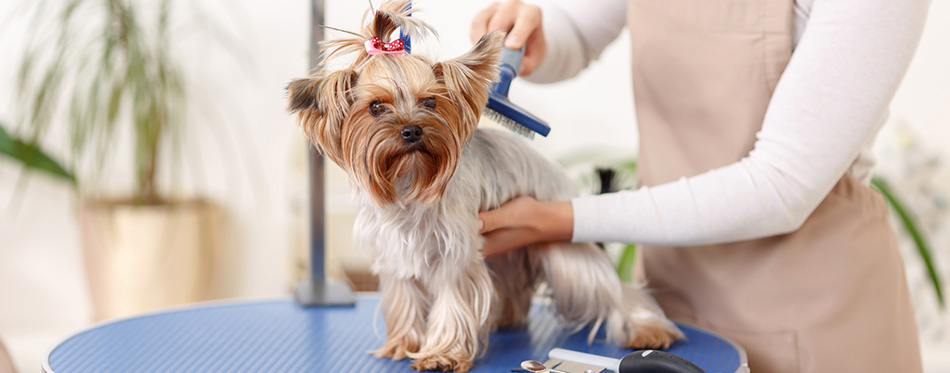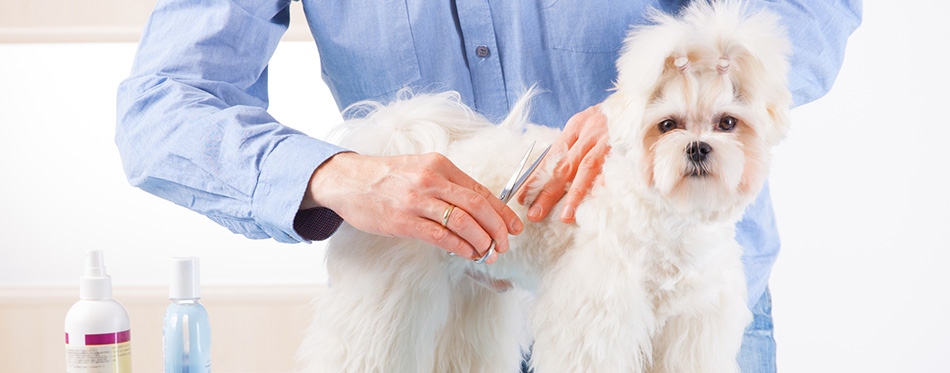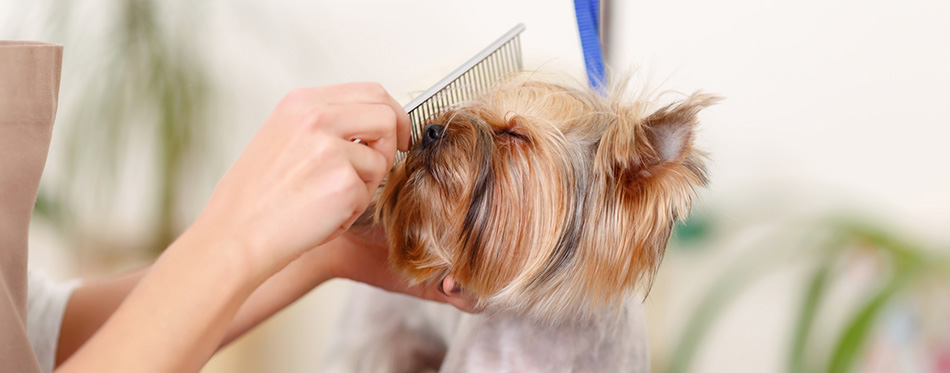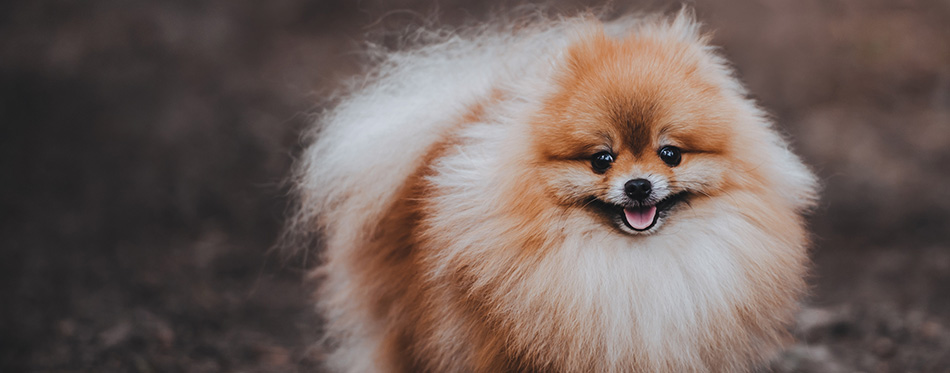Grooming your dog on a regular basis is important for a number of reasons: thorough grooming not only keeps your canine companion looking and smelling fresh, it can also prevent a variety of health problems.
Proper grooming promotes healthy hair, skin, teeth, paws, eyes, and ears. The process itself also provides a great opportunity for bonding with your pet. With all these benefits, chances are you’re keen to learn more. You could seek the services of a professional groomer, but doing the job yourself will save you a lot of money, and help develop a bond of trust between you and your pet. To help you get started, we’ve compiled ten tips from grooming experts everywhere, so you can groom your pooch as safely and effectively as possible.

One: Choose the Right Tools
First and foremost, you’ll need to choose the right tools when grooming your dog. For head to toe grooming you’ll need:
- Medium-toothed comb
- Dog brush (the exact type will depend on your dog’s coat)
- Shampoo and conditioner designed for dogs. Find out more about dog shampoos here.
- Toothbrush and toothpaste designed for dogs
- Dog nail clippers
- Cotton balls for ear cleaning
- Blunt-nosed safety scissors
- Electric clippers if you plan on cutting their coat
- A dog towel
When shopping for grooming products, check the manufacturer’s description to ensure they’re suitable for your dog. Many shampoos, conditioners, and brushes are designed specifically for long or short coats. Using the wrong type of brush for your dog’s coat will reduce its effectiveness, and could be uncomfortable for your dog.
It’s a good idea to gather your grooming products together into one kit, for easy access.
Head over to our reviews of Dog Toothbrushes and Dog Toothpaste.
Two: Teach Your Dog to Enjoy Grooming Time
Grooming is a great way to promote doggie health, and develop trust between pet and owner. Teaching your dog to enjoy the process early in life will make things far easier.
To achieve this, your dog will need to associate grooming with nice treats and attention, and trust that you won’t hurt them. It’s a good idea to begin this regimen from puppyhood for safe and relaxed grooming:
- Get your Dog comfortable with Physical Contact
This will be a gradual process – pet and touch your dog regularly, and offer praise and the occasional treat when they remain relaxed. Begin by getting them used to contact on their back, chest, shoulders, and sides, before moving on to their legs and tail. When they’re comfortable with this, start on their paws – first lifting them up gently, and as they get used to it, spreading the paw pad. This will be important later on for nail trimming. You can also start to gently touch and lift your dog’s lips, to prepare them for toothbrushing.
- Introduce Grooming Tools gradually
Before bathing your pet, show them the tools you’ll be using one at a time. You could also stand your dog in the tub before introducing any water to get them used to the setting. Doing this a few times before their first bath ensures there won’t be any nasty surprises. Praise and provide treats throughout the process to foster positive associations.
- Tire out your Dog First
Before bathing, take your dog for a walk, and allow them to rest for a little while once you return. Exercising before hand promotes relaxation. Speak encouragingly to your dog throughout the process, and stop if they become too stressed. After you’re finished provide them with a treat and more praise.

Three: Know your Dog’s Coat Type
For the best grooming result, it’s important to be familiar with your dog’s coat:
- Smooth Coat – breeds such as Greyhounds, Pointers, and Bulldogs have smooth coats. They’re generally low maintenance, requiring no brushing, and little washing. When you do bathe them, choose a de-shedding shampoo, and a conditioner for extra shine.
- Curly Coat – breeds such as Bichon Frise and Poodles have curly coats. They should be brushed daily with a curved slicker and pin brush. When shampooing, choose a light option with no added conditioner. Acquiring an anti-matting tool is also essential.
- Long Coat – breeds with long coats include Old English Sheepdogs, Shih Tzus, and Maltese. It should be brushed a few times a week with a wooden pin brush – you’ll also need a dematting tool on occasion. When bathing, use a smoothing shampoo, and always use conditioner for reduced matting.
- Short Coat – breeds such as pugs, Labradors, and Beagles have a short coat. It consists of two layers, making it very dense – this it can hold a lot of water, so proper drying should be a priority. They don’t require regular brushing, but a bronze pin brush will help them to shed. Choose a shampoo with deep cleaning properties.
- Wire Coat – these coats can be found on breeds such as Westies, different Terriers
and Schnauzers. For everyday grooming, most brushes will do, but you may need to hire a professional groomer to hand strip their coat from time to time. When bathing these breeds, use a deep cleansing shampoo and forego the conditioner. - Combination Coat – just as humans can have combination skin, dogs can have a combination coat. Breeds such as Cocker Spaniels and Golden Retrievers have both long and short hair. Use a smoothing shampoo and conditioner designed for long hair when bathing, and brush longer areas with a pin brush a few times a week. You might also need a dematting tool.
Four: Take the Opportunity for a Health Check
As mentioned above, grooming can help keep various health issues at bay: it promotes healthy skin, eyes, ears and paws, after all. At the same time, grooming provides a great opportunity to inspect your pet for any health issues, allowing you to nip any problems in the bud.
When grooming your pet, be sure to check that:
- Their coat is glossy
- Their skin is smooth and supple, without flaking, scabbing, or discoloration
- No ticks or fleas are present
- Their eyes are clear and bright, with no signs of redness
- Their gums are pink, with minimal tartar around the teeth
- Their muscles are clearly defined
- Their paws are free from scratches and scabs

Five: Trim Hair Safely
Some dogs will need to have their hair trimmed in order to maintain a healthy and attractive coat. Seek advice from your local groomer or vet before trimming; they’ll be able to tell you which areas should be trimmed on your dog specifically.
Carry out your trimming before giving your dog a bath, so any excess hair is rinsed away. Common areas that require trimming include:
- Around the eyes, where it can impede vision and cause irritation
- Around the anus, where feces can become trapped
- Mats and tangles
- Around the chin and lower jaw where food could become trapped
Use a pair of blunt ended scissors for these tasks. Electric clippers can be used to cut hair on your dog’s body. Choose a pair of clippers that operate quietly, so as not to startle your dog, and clip with the growth direction of your dog’s hair. For more options head over to our guide on dog grooming clippers.
Five: Help your Dog Dry off After a BathAs any owner will tell you, dogs have a seemingly unstoppable instinct to shake water out of their coats when they exit water. However, it’s a good idea to help dogs dry off with a soft towel after their bath.Some coats hold more water than others, and can develop odors if not dried properly. It’s also a good idea to dab excess water out of your dog’s ears with a cotton ball after a bath – this helps prevent infection.
You may also like our guide on Dog Grooming Table.
Six: Help your Dog Dry off After a Bath
As any owner will tell you, dogs have a seemingly unstoppable instinct to shake water out of their coats when they exit water. However, it’s a good idea to help dogs dry off with a soft towel after their bath.
Some coats hold more water than others, and can develop odors if not dried properly. It’s also a good idea to dab excess water out of your dog’s ears with a cotton ball after a bath – this helps prevent infection.
Seven: Look out for Skin Problems
During your health check, look out for these common skin problems:
- Dermatitis
Characterised by exposed patches of skin, and frequent itching or chewing.
- Fleas, Mites, and Ticks
Look out for the bugs themselves, as well as white grains, which may be eggs.
- Hives
Look for round, raised, itchy bumps on your dog’s skin. Hives tend to be a symptom of allergies.
- Ringworm
Watch out for circular, crusty lesions on your dog’s skin. Be careful if you suspect ringworm, as it’s a fungal infection that can also be transmitted to humans.
Eight: Keep Nails in Good Condition
No top to toe grooming session would be complete without paying attention to the paws. Overgrown toenails can make balancing and walking more difficult, and unless your pooch frequently runs around on hard surfaces, you’ll need to trim them every now and then. If you can hear the nails clicking when your pet walks over hard surfaces, it’s time to give them a trim.
Use a pair of nail clippers specifically designed for dogs, and take one paw. Put gentle pressure on the central pad to extend the nails, and carefully cut off a small piece at the end, avoiding the quick. You’ll know you’ve cut the quick if it feels spongy – stop cutting immediately. If you accidentally do cut the quick, you’ll notice some bleeding. Stop this as soon as possible using a nail cauterizer or styptic powder.
Cutting the quick can be very painful for pooches, and they’re likely to remember it! For this reason, you should exercise extreme caution whenever you cut your dog’s nails. If they don’t associate the process with pain, they’re far less likely to put up a fight when it needs to be done again.
Dogs don’t tend to be fond of having their nails cut, so you may need to take breaks between paws – don’t forget to offer plenty or treats and praise when they calmly allow you to clip their nails.

Nine: Be Careful Around the Eyes
As you might expect, cleaning around your dog’s eyes requires special care and attention, due to it being a sensitive area. Just like with humans, globs and crusts can form around dogs’ eyes; unlike humans, they can’t wipe them away.
To clean your dog’s face and around the eyes, use only water, avoiding normal shampoo or soap. Moisten a soft face-cloth and wipe gently. To remove stubborn debris, apply a spritz of dry dog shampoo to the cloth before wiping – avoid using this in the immediate eye area, however.
If you notice dark, blotchy areas on the hair below the eyes, this could mean excessive tear production, which could be a symptom of eye infection. If in doubt, it’s best to check with your vet.
Ten: Don’t Forget About Dental Hygiene
Dogs can develop the same dental problems as humans, but they don’t have the opposable thumbs to take care of their teeth themselves. For this reason, brushing your dog’s teeth is an important part of your grooming regimen.
To brush your dog’s teeth, be sure to use a brush and toothpaste designed specifically for dogs. Human toothpastes contain fluoride, which can be poisonous for dogs. To brush their teeth:
- Give your dog a little of the toothpaste to introduce them to the taste
- Lift their upper lips to expose the gums, and brush gently
- Most pets will only allow you to brush these outside surfaces, so avoid brushing the inner sides of the teeth unless you are completely confident your dog will respond well
If your dog won’t allow you to brush their teeth – perhaps you adopted them later in life, and they’re not yet happy to have their mouth handled – you could consider buying a dental chew. Find out more about dog chews here.
These chews help to remove plaque, promoting healthy teeth and gums, although they should not be seen as a total replacement for brushing. Think of them as sugar-free gum for dogs.
Check out our guides on Dog Bathtubs and Dog Dryer for more info.
Bringing it All together
As we’ve seen, grooming can be a complex process, and what works well for one dog won’t necessarily work well for another.
The key takeaways to remember are as follows:
- Introduce your dog to grooming slowly, from an early age if possible
- Use your grooming time wisely, to carry out health checks
- Be gentle, praise your dog, and offer treats to help them enjoy grooming
- Get to know your dog’s coat to make sure you’re using appropriate products

